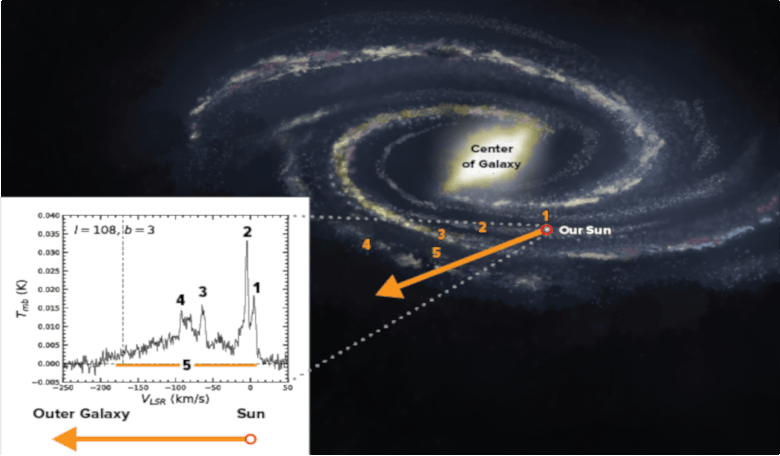A massive, previously unknown structure in our galaxy has been found by astronomers using the world’s largest fully steerable radio telescope – the Green Bank Telescope (GBT); the discovery was so unexpected, it has taken years and many additional observations to confirm the data.
The structure in question is a thick disk of “dark” molecular gas which extends far into the outskirts of the Milky Way and hints of its existence first came to light in 2005, when astronomers found an excess of cosmic rays of unknown origin emanating from the disk of our Galaxy.
“Dark” gas refers to molecules that are difficult to detect in the interstellar medium (ISM) - the vast, cold regions of space between stars. The most prominent is molecular hydrogen (H2).
Despite being the most abundant molecule in the Universe, H2 evades detection easily in these regions as neutral hydrogen atoms (those that have not lost an electron) at temperatures typical of the gas in interstellar space neither emit nor absorb light in the visible part of the spectrum.
H2 is known to produce a signal known as the 21-centimetre line in the ISM, and as it readily penetrates the clouds of interstellar dust particles that obstruct optical observations, it has allowed astronomers to map the galaxy’s spiral structure. But this wavelength signal has such a low frequency and low energy that it requires sensitive radio telescopes to detect it.
Instead, an easier way to find H2 is to look for signals of other molecules known to mix with it in smaller quantities. These are known as “tracer” molecules; the most common is carbon monoxide (CO), but astronomers use other gases such as OH (hydroxide) too.
It was while studying OH emission in 2012 that astronomer Ron Allen, a professor with the Physics and Astronomy Department of Johns Hopkins University, who was working on an unrelated project to the 2005 finding, found clues as to where the cosmic rays might be coming from.
Allen, who has since sadly passed away, had been using CO to show that large-scale distributions of molecule gas were major components in the structure of our Galaxy, but needed another molecule to back-up the data.
He chose OH, and along with Philip Engelke, a new PhD student at the time and also at Johns Hopkins, the two published a number of papers showing that hydroxide was just as useful as CO in the search for galactic molecular gas.
A few years later while reviewing data, Engelke noticed a bump-like feature, which he initially thought corresponded to the Outer Arm of our Milky Way Galaxy.
Follow-up observations revealed a large, faint, broad feature in the entire line of sight – a possible home of the mysterious cosmic rays rays discovered earlier.
To rule out the possibility that this feature could be an instrumental by-product of the GBT itself, rather than an actual feature in the Galaxy, Allen and team set about conducting a number of tests with the Observatory’s 20-meter telescope; a much smaller and older instrument primarily used in educational projects.
Allen and Engelke were subsequently joined by PhD student Michael Busch and happily for the growing team, in 2018, the 20-meter telescope observed the signal from the massive structure.
“To be even more sure, we tried several different independent signal processing techniques on the GBT and 20-metre results to attempt to remove the feature as if it were from the instrumental background, rather than a real signal, and none of these methods managed to remove it,” says Engelke.
This thick disk of diffuse molecular gas had not only gone undetected in every all-sky survey of CO in the past, but also showed that molecular gas is significantly more extended in the outer Galaxy than previously expected; a finding that has implications for star formation theories, as well as the structure, make-up, and total mass of the interstellar medium.
The team’s research was published last week in the Astrophysical Journal and was drafted by Allen’s former PhD students after he passed away in August of 2020.
“We were very lucky to have known him. Ron was truly excited about this discovery, and I know he would have been proud of the result,” reflects Engelke. "Michael and I look forward to continued research inspired by this discovery.”











